Not all the trees in this guide are native to Ireland, but most are. Our island has a small suite of native trees compared with continental Europe.
The meticulous classification of each species in the old Gaelic Brehon laws shows that our culture has traditionally treasured each one of them, but today many of us struggle to recognise these species.
With luck this guide, kindly supported by Gas Networks Ireland, will help you begin to pick out some of them. For an Irish-language version, click here.
How to identify trees
As most of our native trees are deciduous – that is, they shed their leaves every autumn – such species have a distinctly different appearance in winter and summer. And as leaves, flowers and fruit usually offer the easiest routes to tree identification, it's best to start right now, in summer.
Once you learn to ask yourself some key questions, identification becomes easier.
What shape and colour is the leaf? Does it have sharp teeth, curving lobes or smooth edges? Is it simple, which is to say with a single leaf on a stalk, like an oak? Or is it compound, with several leaflets on a stalk, like an ash? Are the leaves hairy?
Tree flowers are sometimes tiny or inconspicuous, and some trees do not flower until they are relatively mature, but they can also provide valuable clues to identity
Tree flowers are sometimes tiny or inconspicuous, and some trees do not flower until they are relatively mature, but they can also provide valuable clues to identity. Do the flowers appear before the leaves, as with hazel? Or do they come afterwards, like oak?
What colour is the fruit, and is it a berry or a nut?
The colour and patterns of bark, the distinctive features of twigs and buds, and of course the general shape and size of the whole tree all help, too, as does habitat. You won’t find many oaks in a wetland, or alders on a well-drained slope.
As a further aid to identification, the National Biodiversity Data Centre's Trees and Shrubs swatch is a good place to start. If you want a deeper dive, the Collins Tree Guide, by Owen Johnson and David More, is invaluable. A comprehensive guide to visiting Irish woodlands is Donal Magner's monumental Stopping by Woods (Lilliput), which you can still find to buy online. – Paddy Woodworth
The trees in these illustrations appear in scale to one another; the leaf illustrations are larger, and out of scale, to aid identification
Alder (Alnus glutinosa)
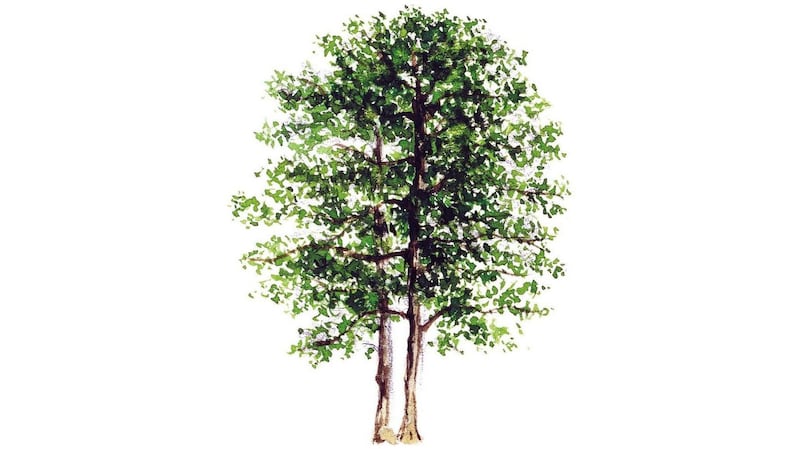
Alder woodlands thrive on wet soils beside lakes and rivers. Wind-pollinated flowers appear before leaves. The male catkins are reddish; the fertilised female cones produce wind-dispersed seeds. The bark is dark brown.

Buds, on hairless twigs, are often mauve. Leaves, which emerge in April, are heart-shaped, toothed and hairless, with tips unpointed or indented. The timber is hard and water-resistant; it turns reddish when cut. Grows up to 20m tall
Ash (Fraxinus excelsior)
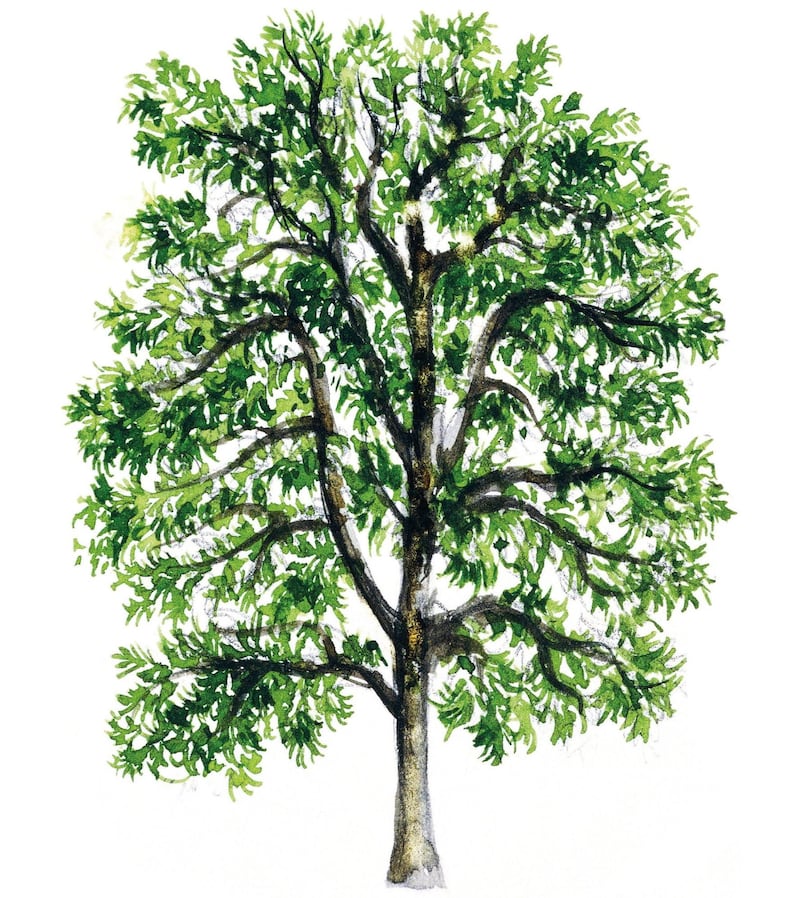
Ash is both the most common tree in Irish hedgerows and a woodland species. It grows best in nonacid, well-drained sites. Twigs are grey with black buds. Dark, wind-pollinated flowers appear in spring long before leaves, which emerge very late, at the end of May. Its compound leaves have up to 13 leaflets.
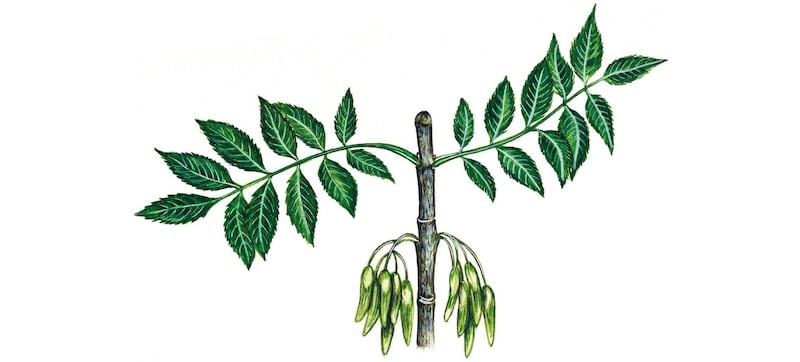
The seeds, known as keys, remain hanging long after the leaves fall. They are winged, for wind dispersal. Ash supports 41 insect species. Hurleys are made from its timber, but this species is threatened by die-back. Grows up to 40m tall, although it is usually much smaller
Hazel (Corylus avellana)
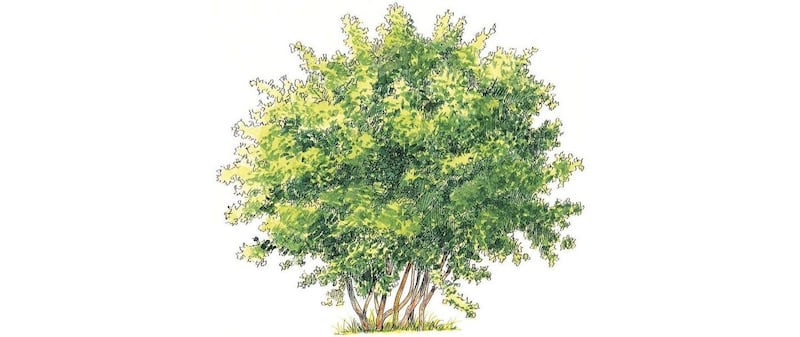
Hazel forms an understorey in deciduous woodlands and in hazel-dominated woods on limestone soils. The twigs have greenish-brown buds. Catkins appear long before leaves, usually in February but sometimes as early as late December. The male catkins are long and pale yellow, and they hang down, swinging in the wind.

Their pollen is wind blown to the tiny budlike female flowers, which have red centres. These develop the hazelnuts early in autumn, two or three together, which turn brown as they ripen. The simple, round leaves with pointed tips, which appear in April, are particularly soft and downy, with hairs on both sides. Squirrels, jays, rooks and mice collect the nuts, storing them for winter food. Grows up to 15m tall
Holly (Ilex aquifolium)
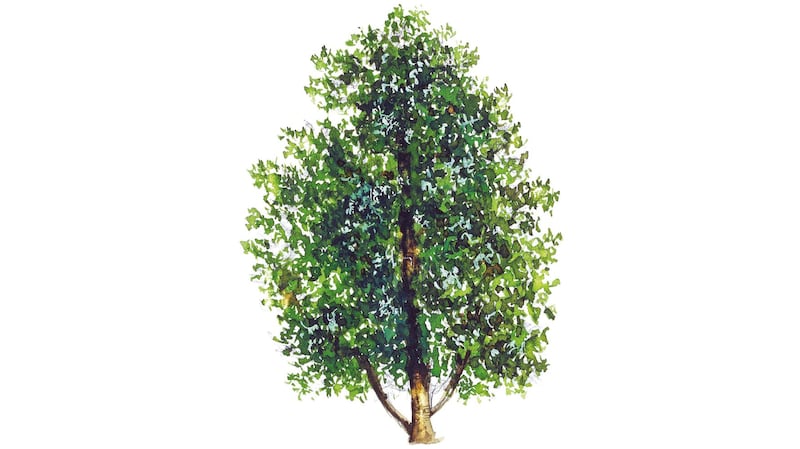
Holly is an evergreen that grows naturally as an understorey in oak woodlands but becomes much taller when standing alone. Each tree is male or female. Both carry small, creamy flowers in May, but only male flowers contain pollen-producing stamens. This pollen is carried to the female flowers by honey bees, bumble bees and solitary bees.

Holly trees' distinctive red berries are particularly prized by mistle thrushes. Their leaves are shiny, with wavy edges and prickles on the lower branches, but on the upper branches of older trees the leaves are flat, with smooth edges and no prickles. Grows up to 20m tall
Horse chestnut (Aesculus hippocastanum)
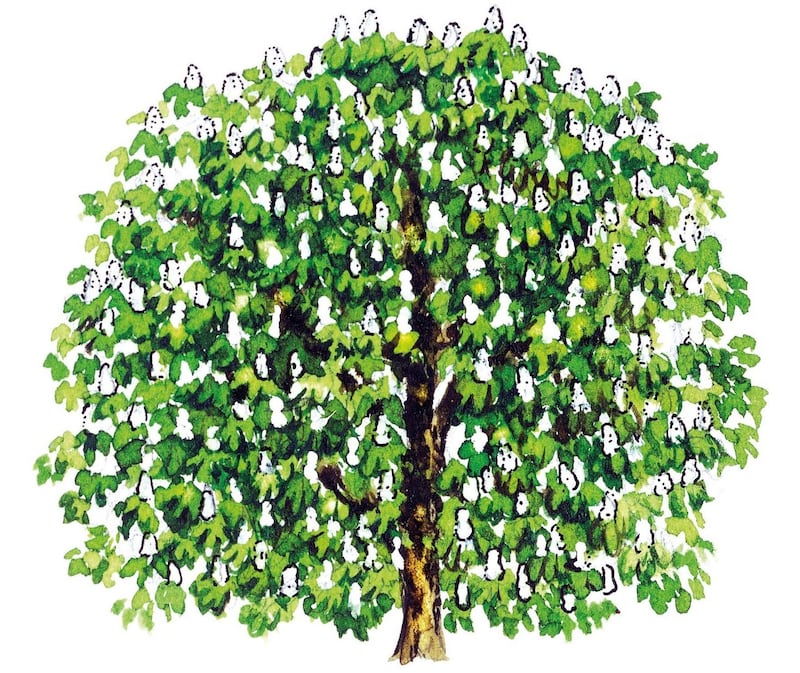
Native to the Balkans, this tree was brought to Ireland in the 1600s to the great estates. Widespread now, it is much loved. The large brown sticky buds open in March, making it one of the earliest trees to come into leaf. Up to seven leaflets radiate from the stalk.
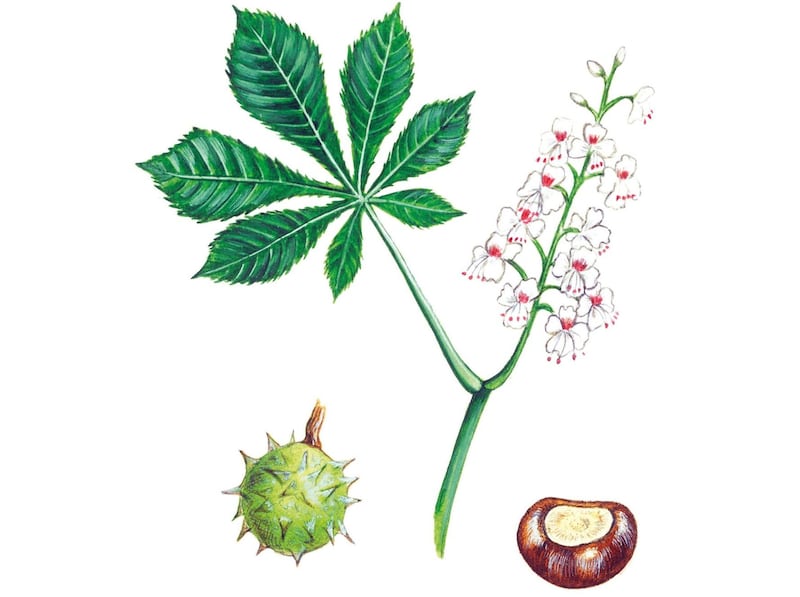
By May the tree is covered with large candles of many white flowers. Pollinating bees make very fine honey from their nectar. The prickly green fruit forms by midsummer, containing the chestnuts, aka conkers, that ripen in autumn to a shiny mahogany colour. We can't eat them, but deer can. Grows up to 30m tall
Rowan (Sorbus aucuparia)
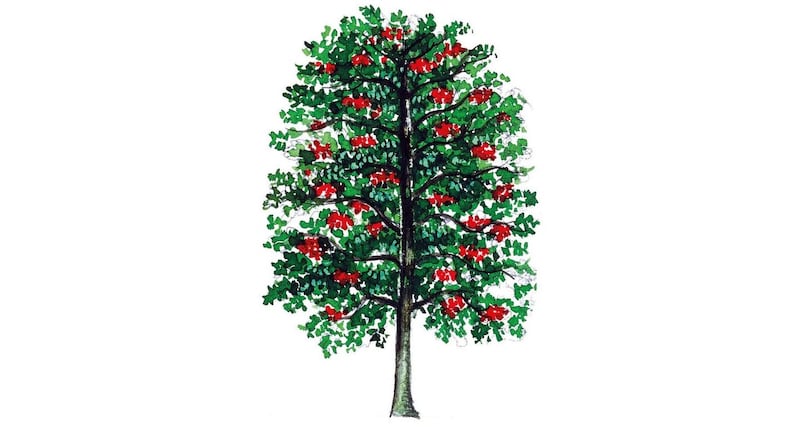
Rowan, or mountain ash, occurs naturally on rocky ground in upland areas. It has a smooth grey bark and grey-brown twigs with buds alternating along them. The compound leaves, opening in April, have up to 15 toothed leaflets.
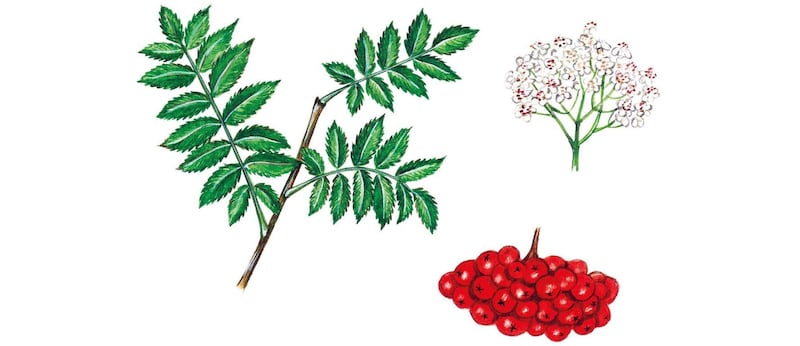
Wide flat-topped clusters of creamy-white flowers in May are insect pollinated. Bunches of scarlet berries in early autumn are prized by thrushes, which will defend their very own rowan tree against all comers. Grows up to 19m tall
Scots pine (Pinus sylvestris)
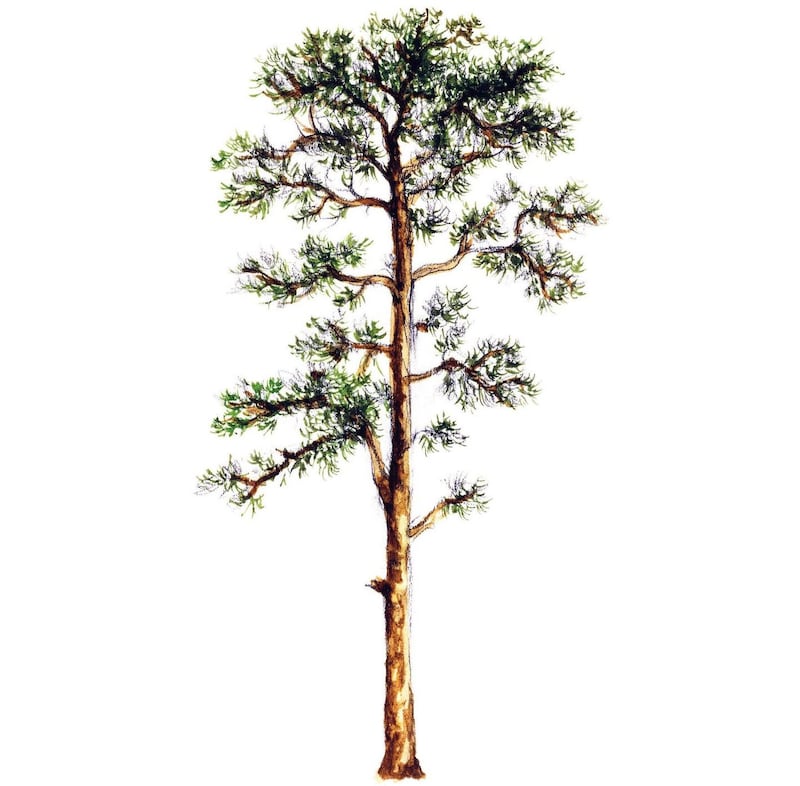
Despite its name, the tall, handsome Scots pine is a native Irish species. Our mountainsides were covered in Scots pine woodlands up to 5,000 years ago, when colder, wetter weather then caused them to be replaced by blanket bogs. Older trees have a bare trunk with a flat crown of foliage and an orange-red bark.
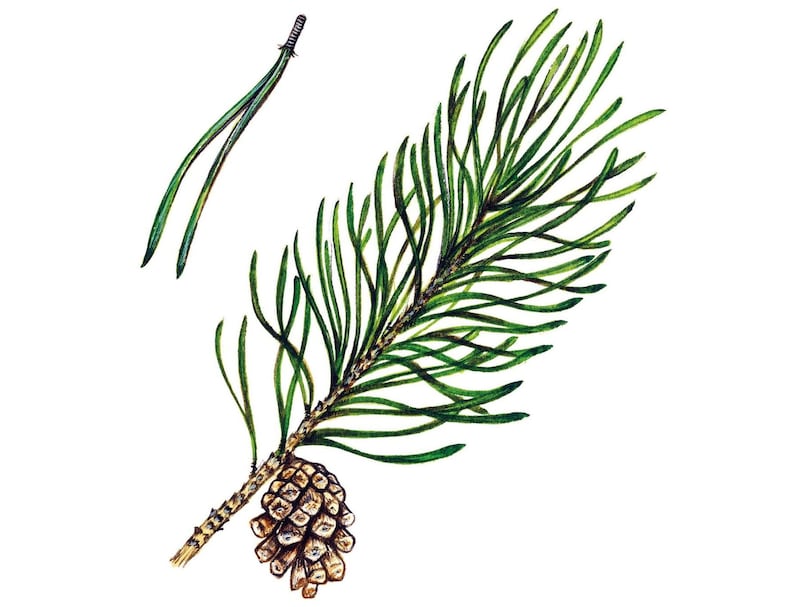
An evergreen conifer, it has as its leaves long needles that are borne in pairs on short shoots. Its cones need two years to mature. Green at first, they turn brown and open when ripe, allowing the small single-winged seeds to be carried away by the wind. These seeds are also the favourite food of the red squirrel. Grows up to 35m tall
Sessile oak (Quercus petraea)
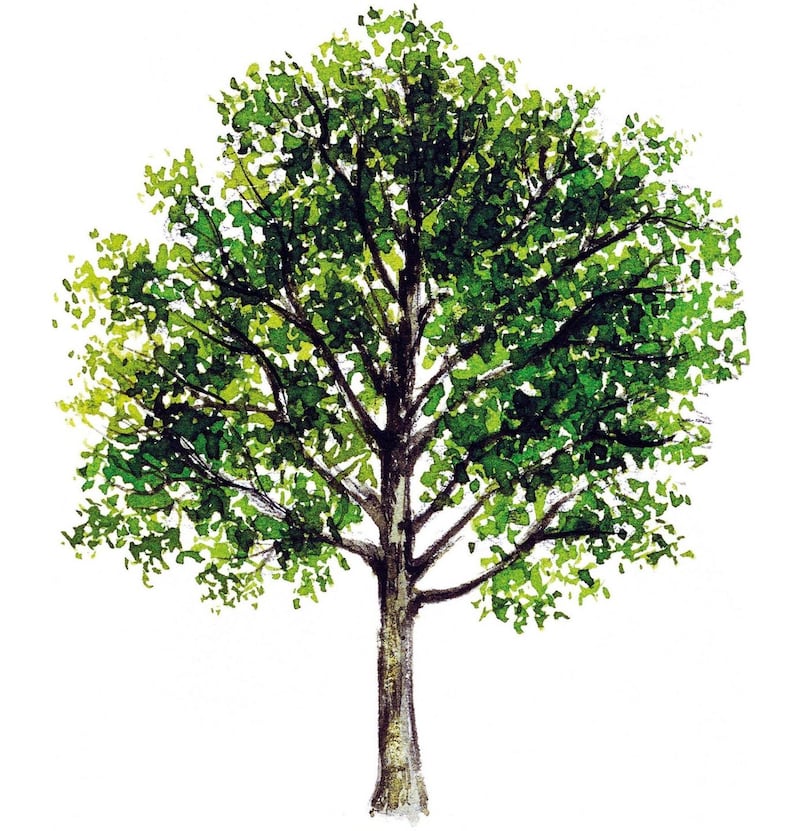
The sessile oak, so-called because its acorns have no stalks but sit directly on the twig, forms semi-natural woodlands on poor acid soils in, among other places, Co Wicklow, Co Donegal, and Killarney, in Co Kerry. Buds are borne on brownish twigs with three or four terminal buds clustered together.
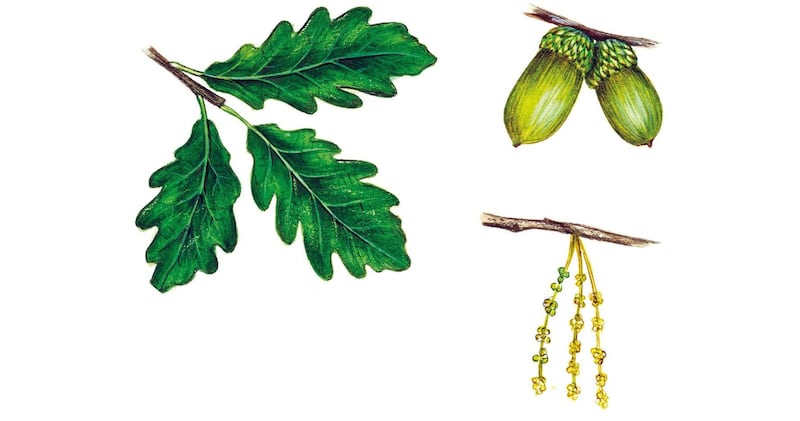
Catkin flowers are produced in early April, the wind blowing the pollen from the males to the females. The characteristic lobed leaves appear in early May. The acorns, which ripen in autumn, are collected to be stored as winter food by squirrels, rooks and jays. Oaks support a huge variety of biodiversity – 286 species of invertebrate have been associated with them. Grows up to 37m tall
Silver birch (Betula pendula)
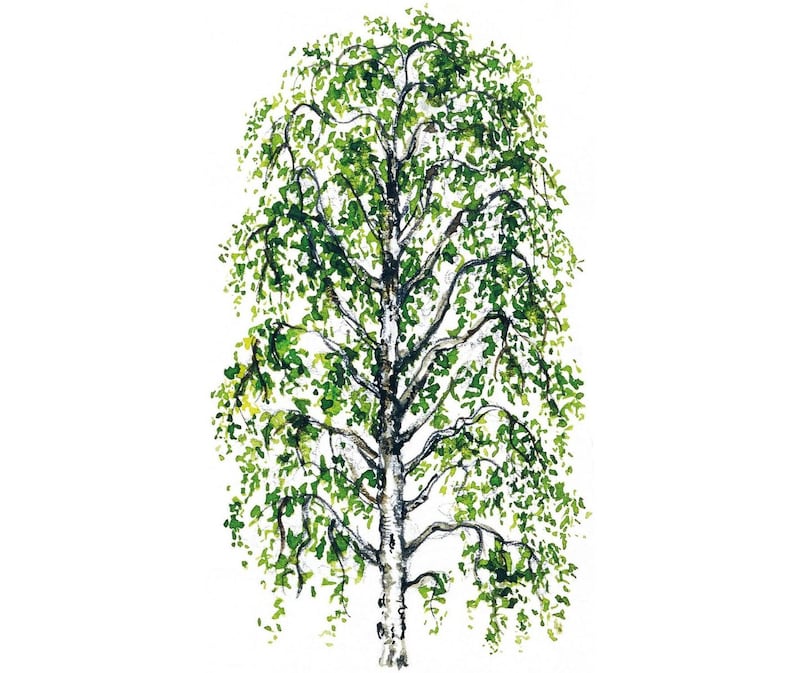
One of two native birches, this elegant tree has drooping, hairless twigs. It has triangular simple leaves, with long slender tips. Male and female flowers, on separate catkins, emerge with the leaves in April.
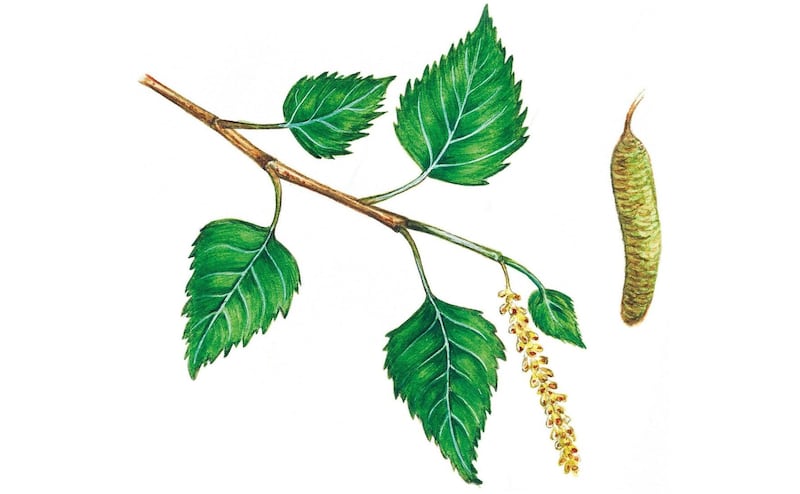
The female catkins are pollinated by the wind, and their small seeds are also wind dispersed. They are popular with seed-eating birds, such as the siskin and the redpoll, and the tree is associated with 229 insect species. Its bark – very pale and cream-coloured, with dark, almost black patches – gives it its name. Grows up to 30m tall
Wild cherry (Prunus avium)
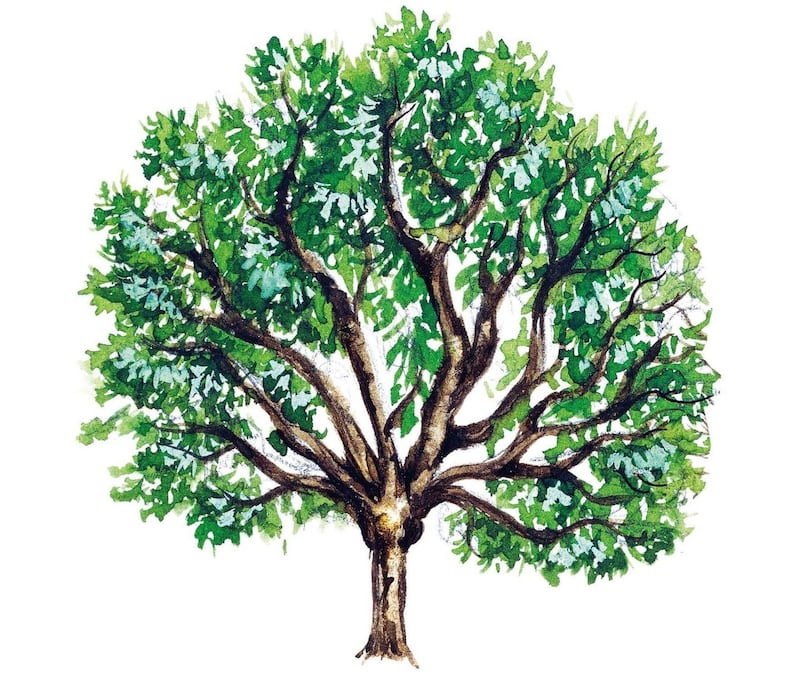
This is the larger of our two native cherry species, often found in deciduous woodland. It is a handsome tree, with shining purple-grey bark. Its simple, oval-shaped leaves, hairy on the underside, appear in early April.
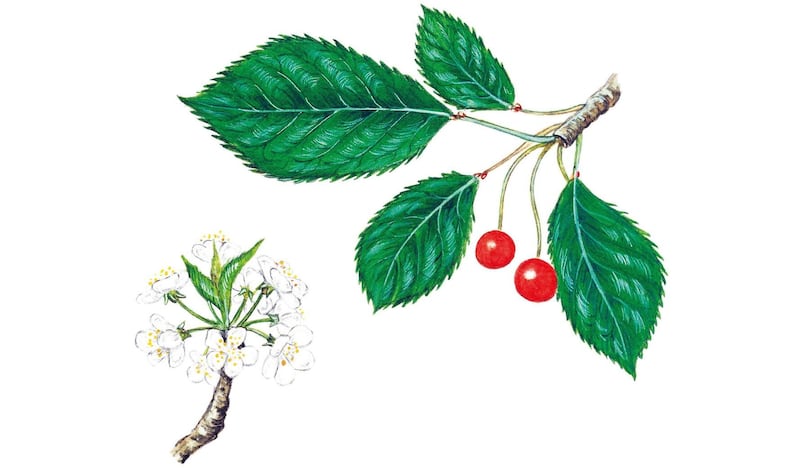
These are followed by pale pink or white flowers, a source of pollen and nectar for insects. The edible dark-red cherries appear in summer and are eaten by pine martens as well as by many birds. The leaves turn red-gold in autumn. Grows up to 30m tall
Wych elm (Ulmus glabra)
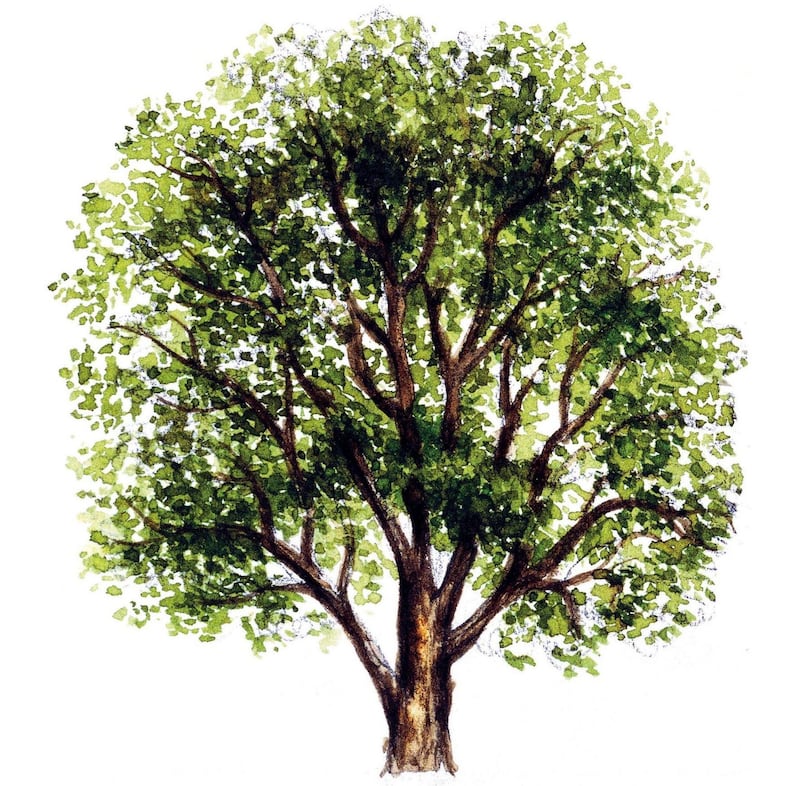
The wych elm is more resistant to Dutch elm disease than the introduced English elm, which was more or less wiped out by it in recent times. Flowers appear in spring, before the leaves.
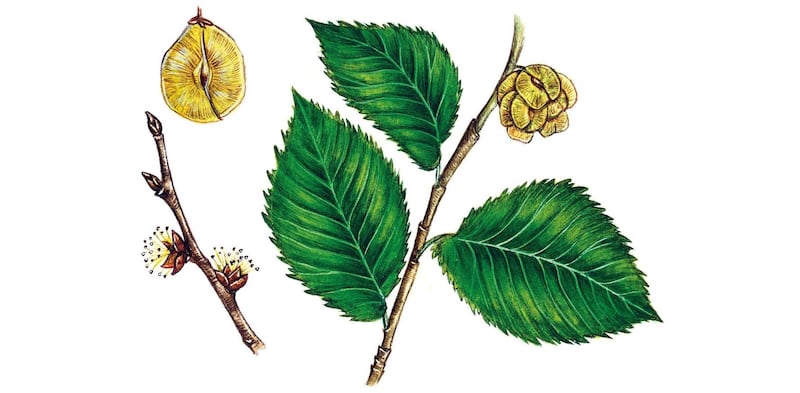
They are reddish clusters, borne directly on the twigs, but are not obvious until they mature into pale green seeds that ripen and then fall off. The leaves, which are rough, like sandpaper, to the touch, are oval, with toothed margins and a distinct tip. Grows up to 35m tall
Yew (Taxus baccata)
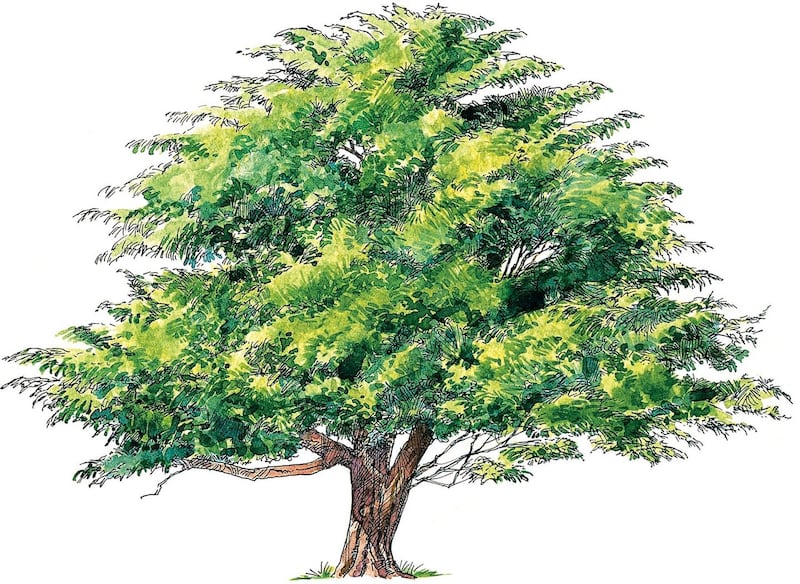
An evergreen, formerly much more widespread than it is now, as many place names show, the yew once formed great woodlands. Killarney’s yew wood is a remnant of these forests. Trees are either male or female. The males bear small cones with pollen that is blown by the wind to fertilise the flowers on the female trees. The fruits are scarlet fleshy berries.
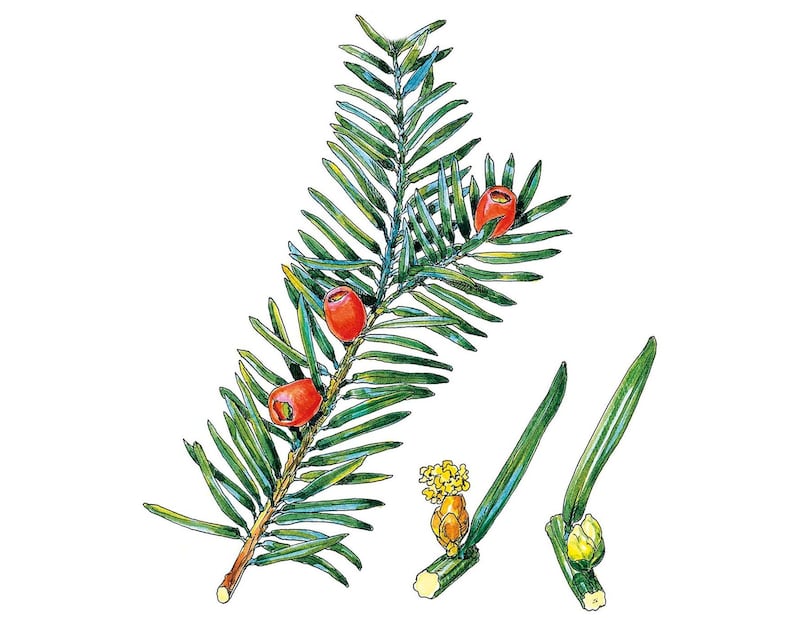
In 1780 a mutant form was discovered in Co Fermanagh with upright branches and, as it was female, red berries. This has been so widely propagated and planted in churchyards and graveyards that it is now the more familiar form. The leaves of all yew are poisonous to livestock, and the seeds are toxic. Grows up to 26m tall
Planting your own trees
Over centuries Ireland has removed more of its native forests than any other European country. Now 90 per cent of our forestry is made up of monocultural alien plantations. Given these circumstances, what should we be planting, and where?
Trees are not appropriate everywhere. Semi-natural grasslands and peatlands are already storing a lot of carbon, they have their own unique species communities, and trees are a bad fit in some of the places where we are planting them.
So we need to plant the right trees in the right places. Nationally, we would ideally plant trees in areas that were forested in historical times, and plant native species that have evolved with our landscapes, as they provide a rich habitat for native fauna and flora.
If you are looking to plant a single tree in a small garden, then a native species appropriate to your area, ideally sourced locally, is a boost for biodiversity
Individually, if you are looking to plant a single tree in a small garden, then a native species appropriate to your area, ideally sourced locally, is a boost for biodiversity.
An excellent source for information on planting native trees is Woodlands of Ireland, an NGO dedicated to forest restoration. Its website offers a range of very helpful publications, plus a direct contact for personal advice.
Companies such as None-So-Hardy and Fermoy Woodland Nurseries can provide locally sourced stock. Make sure you ask for a certificate of local provenance to guarantee your trees meet this criterion. Or you could consider gathering your own acorns, for example, near where you will be planting.
Pocket Forests takes an innovative urban approach codesigned by the Irish Times writer Catherine Cleary.
And if you want to be inspired by one person's delightfully evocative account of restoring a small native woodland, read Richard Nairn's recent Wild Woods, published by Gill Books.
Finally, the cocreator of this guide, the Tree Council of Ireland, has a range of online resources and educational materials on its website.
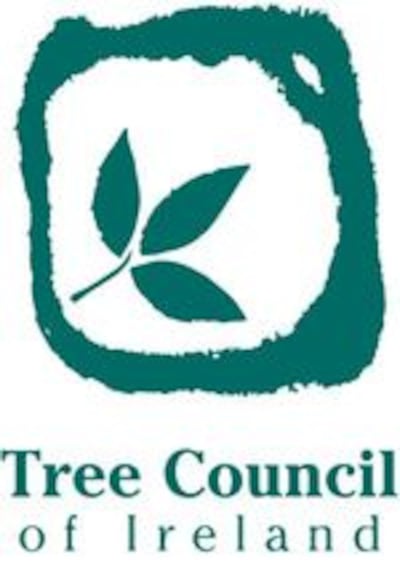
Tree Council of Ireland sponsorship scheme: Gift a Tree and Grow a Forest
This scheme enables you to commemorate a special event, remember a loved one or give the gift of a tree by having a tree planted in the name of a person of your choosing. The tree is numbered, and a personalised certificate is issued recording the name of the person for whom the tree is planted. For full details, please visit treecouncil.ie or email trees@treecouncil.ie

This guide is kindly supported by Gas Networks Ireland
Text: Éanna Ní Lamhna, president of the Tree Council of Ireland. Illustrations: Getty Images. Source: Tree Council of Ireland














